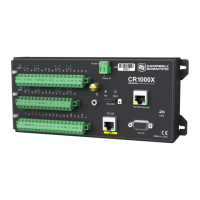configured for SDI-12 to terminal configured for SDI-12), or to copy data to a third-party SDI-12
recorder.
Details of using the SDI12SensorSetup() / SDI12SensorResponse() instruction pair
can be found in the CRBasic Editor help.
When programmed as an SDI-12 sensor, the datalogger will respond to SDI-12 commands M, MC,
C, CC, R, RC, V, ?, and I.
When acting as a sensor, the datalogger can be assigned only one SDI-12 address per SDI-12
port. For example, a datalogger will not respond to both 0M! and 1M! on SDI-12 port C1.
However, different SDI-12 ports can have unique SDI-12 addresses. Use a separate
SlowSequence for each SDI-12 port configured as a sensor.
7.7.4 SDI-12 power considerations
When a command is sent by the datalogger to an SDI-12 probe, all probes on the same SDI-12
port will wake up. However, only the probe addressed by the datalogger will respond. All other
probes will remain active until the timeout period expires.
Example:
Probe: Water Content
Power Usage:
l Quiescent: 0.25 mA
l Active: 66 mA
l Measurement: 120 mA
Measurement time: 15 s
Timeout: 15 s
Probes 1, 2, 3, and 4 are connected to SDI-12 port C1.
The time line in the following table shows a 35-second power-usage profile example.
For most applications, total power usage of 318 mA for 15 seconds is not excessive, but if 16
probes were wired to the same SDI-12 port, the resulting power draw would be excessive.
Spreading sensors over several SDI-12 terminals helps reduce power consumption.
7. Communications Protocols 97

